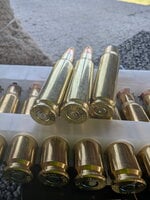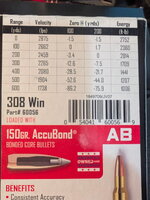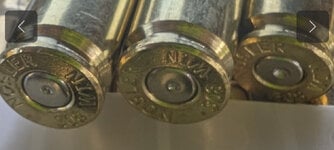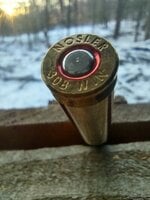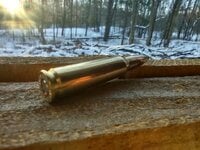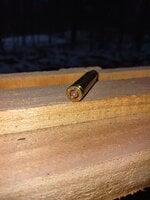Friend had 2 duds. Tried them both again and still nothing. 2 out of 8 didn’t go off. Nosler is replacing them. Questions, are the lot numbers not being put on the inside of the flaps anymore and seems 2 is not normal to have misfires. Seems like a high number and how many more do you think are bad out of the remaining 12.
Navigation
Install the app
How to install the app on iOS
Follow along with the video below to see how to install our site as a web app on your home screen.

Note: this_feature_currently_requires_accessing_site_using_safari
More options
You are using an out of date browser. It may not display this or other websites correctly.
You should upgrade or use an alternative browser.
You should upgrade or use an alternative browser.
Misfire
- Thread starter jezzolo
- Start date
DrMike
Ballistician
- Nov 8, 2006
- 38,107
- 8,107
QC seems definitely absent in this lot.
RL338
Handloader
- Mar 23, 2017
- 4,375
- 7,631
I wonder who’s primers they’re using.
salmonchaser
Ammo Smith
- Dec 13, 2013
- 5,771
- 7,760
My experience with factory ammo is limited to primarily that purchased by my department. The budget was in the neighborhood of a million rounds a year to cover duty, practice and specialty assignment and academy training. I would guess less than 1/4 of that number was rifle ammo. (223/556 and 308). Very little shotgun ammunition and most of that was less lethal munitions.
I do recall a few misfires from practice ammunition over a 20 year period. I do not recall any with duty ammo. It seems exceedingly rare.
I do recall a few misfires from practice ammunition over a 20 year period. I do not recall any with duty ammo. It seems exceedingly rare.
- Nov 4, 2004
- 26,748
- 12,733
That's disappointing
JD338
JD338
can you weigh them ? maybe missing powder . just a guessFriend had 2 duds. Tried them both again and still nothing. 2 out of 8 didn’t go off. Nosler is replacing them. Questions, are the lot numbers not being put on the inside of the flaps anymore and seems 2 is not normal to have misfires. Seems like a high number and how many more do you think are bad out of the remaining 12.
Blkram
Handloader
- Nov 25, 2013
- 3,310
- 4,055
As with anything manmade, there are going to be times when things aren't what they should be, and they fail.
It could be a primer issue...
There was a span of time (late 90's or early 2000's, I don't recall exact dates at the moment) when Winchester primers were having issues, both as components and in factory loaded ammunition, where they just did not ignite. It wasn't unusual to find a number of primers in a box, or cartridges in a box of factory ammunition, where they wouldn't fire the load. And it was frequent enough that one just cycled another round and tried again. I would just unload the cartridge and reload with a new primer and try again.
For the remainder of loads in the box, it is hard to say how many more will not fire. If unsure, use for target practice only so you don't miss any opportunities in the field.
Did he buy more boxes of ammo at the same time? And any issues with the other box?
On another note, the issue could be mechanical. I would have a gunsmith check the rifle's firing pin to ensure that there is nothing wrong with it, just to eliminate that possible variable. (It may not be punching full length for some reason...I cannot tell from the photo, but the firing pin strike may be a little light.)
It could be a primer issue...
There was a span of time (late 90's or early 2000's, I don't recall exact dates at the moment) when Winchester primers were having issues, both as components and in factory loaded ammunition, where they just did not ignite. It wasn't unusual to find a number of primers in a box, or cartridges in a box of factory ammunition, where they wouldn't fire the load. And it was frequent enough that one just cycled another round and tried again. I would just unload the cartridge and reload with a new primer and try again.
For the remainder of loads in the box, it is hard to say how many more will not fire. If unsure, use for target practice only so you don't miss any opportunities in the field.
Did he buy more boxes of ammo at the same time? And any issues with the other box?
On another note, the issue could be mechanical. I would have a gunsmith check the rifle's firing pin to ensure that there is nothing wrong with it, just to eliminate that possible variable. (It may not be punching full length for some reason...I cannot tell from the photo, but the firing pin strike may be a little light.)
truck driver
Ammo Smith
- Mar 11, 2013
- 7,501
- 1,303
After load a few hundred thousand rounds I have found that it can be lots of things to cause a miss fire.
Remington ran through a bad time with .22lr because the priming material wouldn't stick to the inside of the rim of the case.
I have looked at light hits by firing pins and found 3 causes, 1 a weak spring causing light hits and 2 a shortened firing pin due to wear and even a broken firing pin that would still set off rounds, even chamber head space can be the problem. Most of the times it is a component that causes the miss fire, contaminated powder or primers is usually the cause, not something QC can find easily.
Remington ran through a bad time with .22lr because the priming material wouldn't stick to the inside of the rim of the case.
I have looked at light hits by firing pins and found 3 causes, 1 a weak spring causing light hits and 2 a shortened firing pin due to wear and even a broken firing pin that would still set off rounds, even chamber head space can be the problem. Most of the times it is a component that causes the miss fire, contaminated powder or primers is usually the cause, not something QC can find easily.
Ridge_Runner
Handloader
- Sep 29, 2006
- 1,434
- 845
even the primer detonating would drive the bullet into the lands.can you weigh them ? maybe missing powder . just a guess
RememberBaker
Beginner
- Dec 2, 2012
- 137
- 68
not always . in my 1911 , 45 acp I pushed a 185gr LSWC over halfway through the bbl with a win LP , non mag primer . this bullet was crimped too . in my 338 lapua , a 215M primer did not move the bullet . this bullet was graphite lubed before seating . the brass had .002 neck tension , and not crimped . I " THINK" case capacity has a lot to do with how a primer only reactseven the primer detonating would drive the bullet into the lands.
- Nov 4, 2004
- 26,748
- 12,733
I had a misfire on a deer last deer season. The temps were in the low teens. The rifle was a Nosler M21 in 308 Win with one of my proven loads.
The root cause was some moisture on the firing spring. The cold temps were enough to freeze up the spring and cause a light strike on the primer.
I did kill a deer that afternoon and haven't had any more issues.
JD338
The root cause was some moisture on the firing spring. The cold temps were enough to freeze up the spring and cause a light strike on the primer.
I did kill a deer that afternoon and haven't had any more issues.
JD338
Attachments
TackDriver284
Handloader
- Feb 13, 2016
- 2,940
- 3,158
That exactly happened to me on a deer hunt when I pulled the trigger on a 10 point buck, click, then chambered again, click and once more, click. We headed back to camp and grabbed a 25-06 and went back out to see if we could find him, saw him again that evening and got him. It was about 30 degrees and the grease hardened up in the bolt around the spring and prevented it from functioning properly. when we got back home, once temps was back around 85 degrees, the rifle worked like normal. A breakdown of the bolt and cleaning fixed the issue.I had a misfire on a deer last deer season. The temps were in the low teens. The rifle was a Nosler M21 in 308 Win with one of my proven loads.
The root cause was some moisture on the firing spring. The cold temps were enough to freeze up the spring and cause a light strike on the primer.
I did kill a deer that afternoon and haven't had any more issues.
JD338
- Nov 4, 2004
- 26,748
- 12,733
Truer words have never been spoken.As Evan Marshall was fond of saying, “Any man made item can and will fail. Even man himself.”
Vince
JD338
years ago , I used to clean my bolt / firing pin assembly , and put it together completely dry . I often thought about rust forming . now I finishing cleaning by rinsing with cigarette lighter fluid . according to jewell trigger , lighter fluid has a slight lubricant to it , and doesn't hold dust . there's also nothing there to get gummy , or stiff when cold .
- Nov 4, 2004
- 26,748
- 12,733
That's a great idea Jim. Thanks!years ago , I used to clean my bolt / firing pin assembly , and put it together completely dry . I often thought about rust forming . now I finishing cleaning by rinsing with cigarette lighter fluid . according to jewell trigger , lighter fluid has a slight lubricant to it , and doesn't hold dust . there's also nothing there to get gummy , or stiff when cold .
JD338
Ridge_Runner
Handloader
- Sep 29, 2006
- 1,434
- 845
sorry didn't know we were talking about a 338 LM.not always . in my 1911 , 45 acp I pushed a 185gr LSWC over halfway through the bbl with a win LP , non mag primer . this bullet was crimped too . in my 338 lapua , a 215M primer did not move the bullet . this bullet was graphite lubed before seating . the brass had .002 neck tension , and not crimped . I " THINK" case capacity has a lot to do with how a primer only reacts
Similar threads
- Replies
- 2
- Views
- 469
